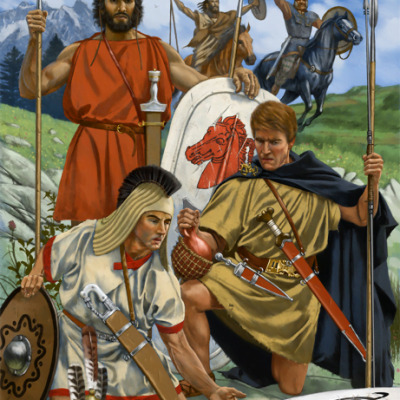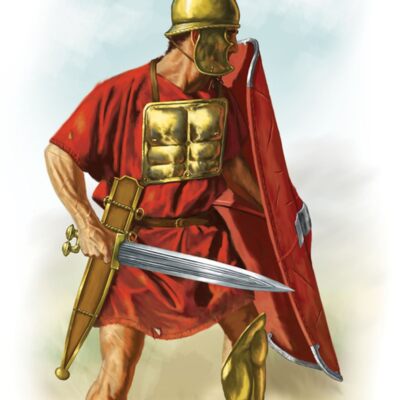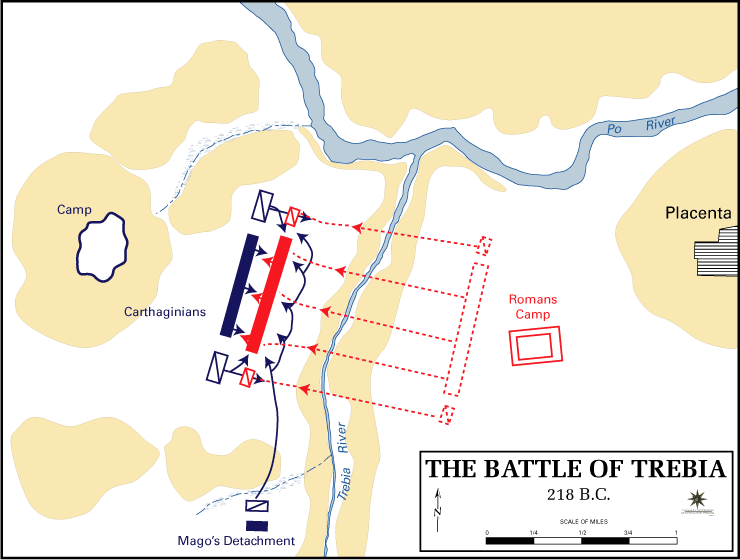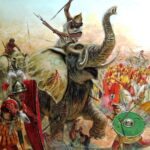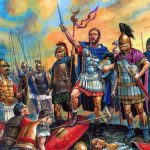Chapters
Battle of the Trebia (218 BCE) was the first great clash between Carthage and Rome in the Second Punic War. The troops of the Republic were completely defeated by Hannibal’s army. In this battle, Hannibal first used the tactics that brought him a great victory at Cannae.
Historical background
The turbulent events of the Second Punic War are primarily associated with the military genius Hannibal, which most fully manifested itself below Cannae. The Carthaginian army then crushed the Romans by flanking and surrounding the much larger armies of the Republic. In general consciousness, the first clash of the Punic army with the Romans two years earlier turned out to be relatively less “media” when Hannibal used similar tactics.
After the peace at the end of the First Punic War, relations between the two countries were not unequivocally hostile. However, neither side renounced the return to the warpath. The defeat of Carthage in the First Punic War evoked a sense of humiliation in part of her society, further strengthened by the Roman partition of Sardinia. Weakened by the loss of part of the territory of Carthage, it compensated for this by the intensive conquest of the lands of the Iberian Peninsula. This expansion raised anxiety of the Senate, which resulted in the signing in 226 BCE of a treaty between Carthage and Rome, designating the Ebro River as a dividing line of the zones of influence of both countries. At one point, however, the Roman republic entered into an alliance with the city of Sagunt. Inhabitants of this city could seek help from the Quirites, feeling the threat of expansion of the Barkids in Spain. Later, the Romans were asked to mediate in a dispute among local politicians. Some of them leaned towards Rome, others showed pro-Carthaginian sympathies. In 221 BCE, Hannibal took command of the Carthaginians in Spain. At the turn of 219/218 BCE, a dispute broke out between Sagunt and the neighbouring city, Carthage’s ally. The Saguntians accused the rival of taking part of the territory. Of course, Saguntu’s rivals were supported by Hannibal. In the winter, the Romans’ envoy hosted a Punian chieftain in Spain and reminded him of the treaty’s provisions, warning against attempts to attack Sagunt. Disgusted with a negative response, Roman parliamentarians then repeated these demands to the Carthage authorities. Hannibal besieged Sagunt and conquered the city after an 8-month siege. The Romans sent another commission to Carthage asking about the attitude of its authorities to Hannibal’s actions in Spain. In response, Carthaginian senators refused to comply with the 226 BCE treaty, explaining that it had not been ratified. At the same time, they referred to the peace conditions proposed by Catullus 241 BCE and questioned the alliance of Rome with Sagunt. After the failure of mutual consultations, both sides began preparations for the war.
Plans for both sides
The Romans planned to strike at Punisans in two places. One of the consuls of 218, P. Cornelius Scypio, at the head of the consular army and allied forces, supported by 60 quaternaries, was to move to Spain. His colleague, T. Sempronius Longus with the consular army, allied forces, 160 five-rowers and several lighter units was to invade Africa. However, these plans were ruined by accidents in Gaul Cisalpin, where Celtic tribes turned against Roman colonists. The army of Manlius Wulson fighting in this section was ambushed in a wooded area and suffered heavy losses. The commander himself was besieged near Tannetum. The Senate sent the army of Atilius Serranus to his rescue, who easily dealt with defiant tribes. Scipio, by order of the Senate, was forced to recruit a new legion and ally forces to replace the army sent to Gaul. The resulting delay in his invasion of Spain had a decisive impact on the course of hostilities in the near future. Hannibal also planned to conduct the war in an offensive manner and wanted to attack the Romans on their own land. This could not be carried out by sea invasion due to restrictions imposed on Carthage in the treaty of 241 BCE. The only solution remained the difficult march through the Pyrenees, southern Gaul and the Alps. It was the procession of the Carthaginian army that amazed the Romans with this route.
Hannibal’s march to Italy and the first fights
At the end of April 218 BCE Hannibal headed an army of 60,000 and set off from New Carthage north. 14,000 African people commanded by Hasdrubal remained in Spain as a garrison. The invasion army consisted of representatives of many nationalities – Carthaginian, Libyan, Iber and Celtyber citizens. After crossing the Ebro, the Carthaginians set off towards the Pyrenees. During the march, Hannibal learned of the Romans’ preparations for warfare, which confirmed his intention to attack Italy. The chief separated 10,000 soldiers from the whole army to conquer mountainous areas and fortresses north of Ebro. During the march to the Pyrenees, 3,000 soldiers from the Carpathian people deserted from the camp. Hannibal, however, allowed the Spaniards to go home voluntarily. 7,000 Celtybers who decided to take this step were sent to Hasdrubal. Through the Gaul territories, the army reached Rhone, where after fighting with the local Celts, the camps and people were transferred to the other side. Upon hearing of Scipio’s landing near Massilia, Hannibal headed north to avoid fighting the enemy. So Scipio sent his brother and army to Spain, going alone to Pisa and Ariminum to protect the mountain passes on the Adriatic. At the same time, Sempronius Longus’s army was withdrawn from Sicily and sent back to the Po to resist Hannibal. This Druence Valley came to the summits of the Alps. It took Hannibal 15 days to cross the mountains and caused great losses. Of the 38,000 infantry and 8,000 cavalries that crossed the Rhône, 20,000 infantry and 6,000 cavalries remain after crossing the Alps. The elephants suffered the most, most of which did not survive the march through the snowy mountains. Hannibal headed toward the Taurine lands, which were hostile to him.
After conquering their main centre and a short rest, the Carthaginians set off to the lands of the allied Insubres and Bojs. Over Ticinus there was the first victorious clash of Hannibal’s army with Roman forces. Consul Scypion was seriously wounded in the battle, rescued according to one source by his son, the future winner of Hannibal. The battle raised the morale of the invasion army. From that moment, the Romans became conservative in warfare, and this was read as a sign of weakness. This was seen by representatives of the Gallic tribes, who after the victory began to lean toward Carthage. Meanwhile, Sempronius’ consular army came in a strenuous march from Sicily to the new theatre of war, although there are still disputes among historians about how this march took place. The relatively short duration suggests that part of this route legionaries could travel by sea. The differences also concern other details of this procession. According to Polybius, Sempronius reportedly ordered his subordinates alone or in groups to cross north and appear in Ariminum on the appointed day. However, according to this historian, this army was to march under the walls of Rome to encourage its inhabitants. It was the period just after the Senate received information about the defeat of Ticinus.
Battle of Trebia, Winter 218 BCE
Initially, Consul Scipio did not take action against Hannibal, who was in a convenient position far from the banks of the Trebia River. Barcid was also reluctant to fight. It is possible that at that time he was more interested in dragging Celtic tribes to his side. However, Hannibal suspected them of duplicity and a pact with the Romans. A Carthaginian unit of 1,000 cavalries and 2,000 infantry began to plunder the area, which was considered by some of the local Celts to be hostile. Some of them asked the Romans for help, who crossed 1,000 velites and a strong cavalry unit. The Carthaginians scattered throughout the Trebia Valley and burdened with loot could not resist the attack of these forces. The Roman cavalry chased them all the way to Hannibal’s camp, which he finally sent to his aid. The attack from the camp rejected Roman horsemen, however, both sides began to engage more and more units in this fight. The cautious Hannibal finally ordered to stop his subordinates from the fight, which the Roman commander gave up, satisfied with his success.
Consul, commanding all of the Roman forces, Sempronius Longus, encouraged by a victorious skirmish, opted for an armed confrontation with Hannibal. He was counting on victory in the battle against Barkida, which he needed in the upcoming elections. He didn’t want to wait until his injured colleague wanted to share the laurels with him. The willingness of both sides to fight a major battle is perfectly understandable. The Roman commander understood that he had numerical advantage over the enemy and defended his territory. The Roman staff was aware that Hannibal’s army was weakened by a strenuous march through the Alps, and the possible postponement of fighting until spring could mean the recruitment of more Gauls to its ranks. What’s more, postponing the battle could be considered by the enemy as a sign of weakness. Winning the battle could lead to desertion of Celtic tribes from Hannibal’s army. The Punic commander was also in a hurry to the general confrontation, which was supposed to boost his campaign. The area of future operations was perfectly suited to both the use of incomparable Carthaginian cavalry and to the use of legionary infantry by the Romans. It was a flat plain turning into hills in the south. The Punic chieftained a watercourse that crossed the plain flowing in the south between two steep and wooded slopes. By placing a squad of 1,000 infantry and 1,000 Numidian cavalry under Magon at night, he prepared an ambush on the Romans. This grouping was to emerge from hiding and hit the rear of the Roman formation at the crucial moment of the battle. On the basis of information from spies and conclusions from the reconnaissance, Hannibal learned his and Sempronius’ abilities.
Before dawn the next day, Barkida sent 500 Numidian horsemen to attack the Roman camp. The Numidians, according to the order, forged Trebia and attacked the camp of both consuls. Sempronius picked up all his cavalry along with 6,000 velites and threw these forces on the attackers. At the same time, he ordered infantry troops to attack the river. Hungry, unprotected and unexplored walkers crossed the river in three columns, wading in icy water up to their shoulders. It took some time for all manipulates to take up combat positions on the other side of Trebia. The armies of both consuls had a total of 16,000 legionary infantry and 20,000 auxili infantry. Researchers estimate that 6,000 light infantry fought in the Roman ranks. After 2,000 rides, it was to stand on each flank in front of Hannibal’s more than a twice as large horse. The entire Roman front was in the form of a traditional manipular style with legions in the centre, auxiliary infantry on the sides and riding on the flanks. The Punic army consisted of 21,000 heavily armed infantry, 8,000 light armed and 11,000 cavalries. 8,000 Gauls stood at the centre of Hannibal’s formation, Spanish and Libyan infantry on both of their flanks. Spanish and Gallic riders, supported by the Numid, occupied the flanks of the entire formation, 5,000 men each. Sources say that elephants were set up on the wings of the Iberian and Libyan infantry. Roman legionaries were slow but confident in the direction of the enemy formation.
As in many clashes of this era, the combat began with the armed men of both sides. Velites, less experienced and weakened by the previous fight with Numid, succumbed to Hannibal’s excellent slingers. When the main forces clashed with each other, the light-armed men of both sides withdrew behind the heavy-armed ranks or on the flanks. The fastest settlement took place on the flanks, where the weaker and tired Roman ride gave way to more numerous Punic riders. Carthaginian cavalry came out on both wings of the enemy and got into a fight with soldiers mounted on flanks auxiliarii. Infantry fighting in the centre was fierce and for a long time, the result was difficult to predict. Manipulas hastati and principes significantly outnumbered the Punic infantry and consisted of units dressed in heavier armour than their Carthaginian opponents. The long Roman front allowed longer legion resistance in the centre and it took a long time before the defeat of the Romans on the flanks disorganized the centre of the Roman formation. The strong resistance of the legions did not cease even when Magon’s ambush attacked the rear of the Romans. It was pressure from the front elephants and infantry of the enemy and Numidians and skirmishers from the flank that led to the breaking of the wings of Roman infantry. Only legionaries in the middle of the front defeated the Gauls fighting with them and in 10,000 they broke through the triumphant Carthaginian ranks. The others died in battle and were captured or scattered.
The meaning of battle
Consul Longus tried to present the harsh climatic conditions as the real cause of the defeat at Trebia. It took a long time before the Senate estimated the real losses suffered in this battle. Ultimately, Longus was found guilty of the entire catastrophe, but the achievements of the Roman infantry were appreciated, who through their steadfast stance in the centre of the formation managed to escape the trap. Assessing the struggle from a purely strategic point of view, the clash is primarily a testimony to the professionalism of Hannibal, who at first kept his people in check, deciding himself about the place and time of the fight with the enemy.
The battle itself can be considered a trailer for Cannae. Already then Hannibal used flanking tactics, which he repeated in 216 BCE. In the battle, a larger and well-trained Punic ride played a large role. In the fight, he focused his strength on the clash of the wings of the centre of the array. Libyan and Spanish infantry placed on them, with the support of elephants, successfully stopped the legionary’s impetus, weakened by Magon’s attack on the rear of the formation. Legionaries in this situation had to direct their third battle line there. However, over Trebia, Hannibal could not quite flank the enemy, because the middle of his formation was too weak, enabling the Romans to break through. From the point of view of the morale of the Punic army, Trebia raised Hannibal’s faith in the possibility of defeating the enemy in a further campaign. The Gauls from the north of the peninsula began to treat the Carthaginians with even greater kindness. The Insubras renewed their oath of allegiance and pledged to provide reinforcements. The Ligurians also paid homage to Hannibal. A total of 10,000 Gauls joined the ranks of Hannibal.



